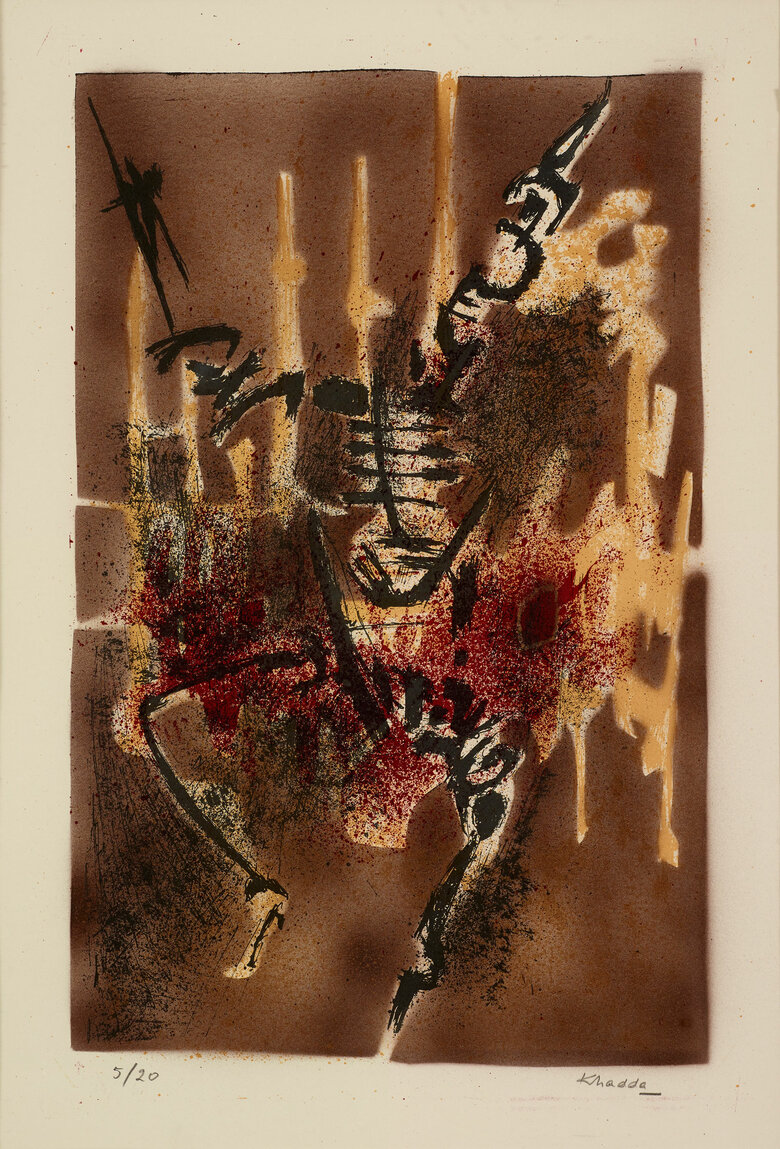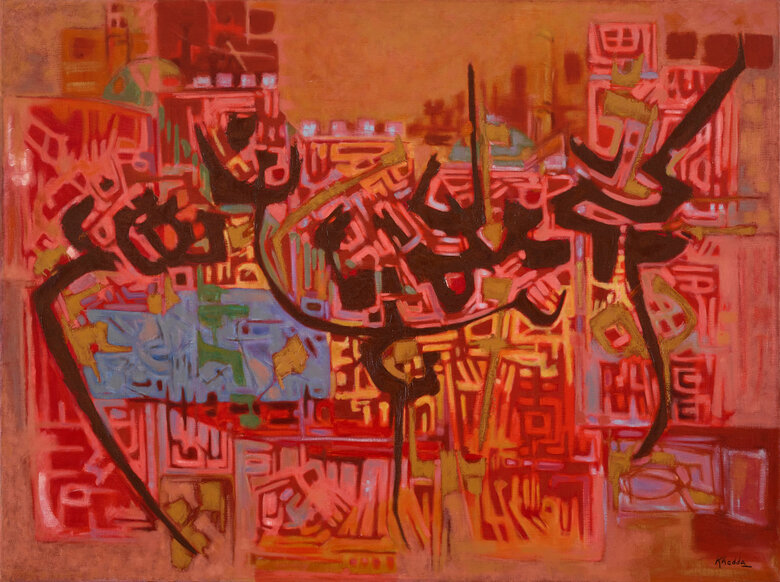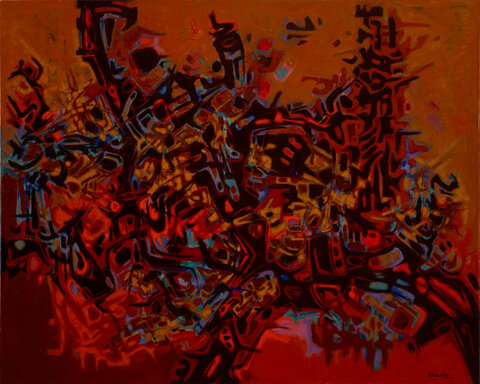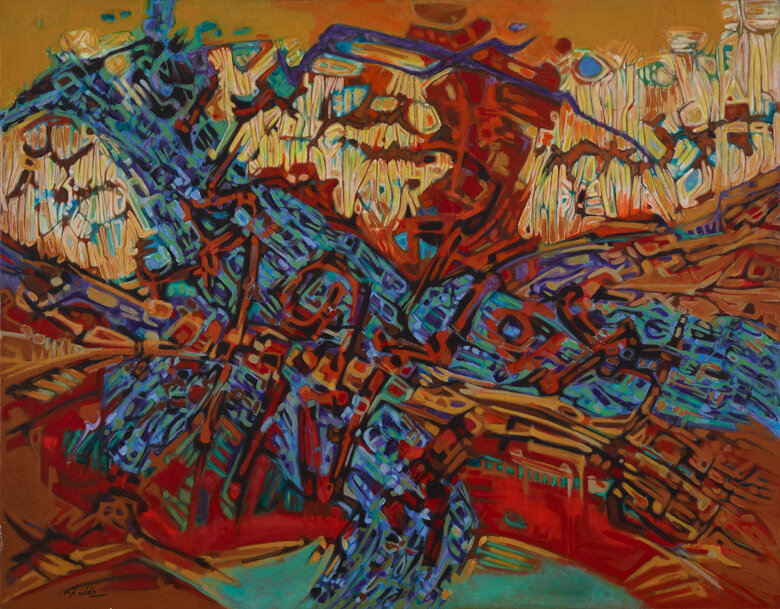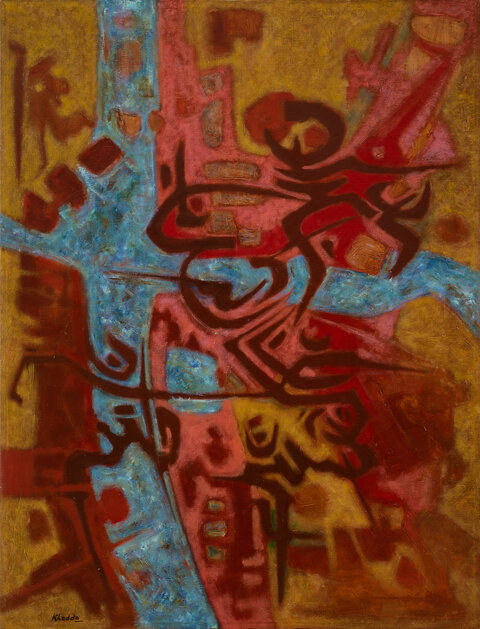Written by Arthur Debsi Born in 1930 in the coastal city of Mostaganem, Algeria, Mohammed Khadda came from an underprivileged family, when the country was a French territory. In 1942, he had to...
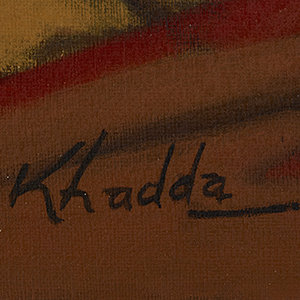

MOHAMMED KHADDA, Algeria (1930 - 1991)
Bio
Written by Arthur Debsi
Born in 1930 in the coastal city of Mostaganem, Algeria, Mohammed Khadda came from an underprivileged family, when the country was a French territory. In 1942, he had to interrupt his education, to move with his family to Tiaret because of the famine occurring in his hometown. After a few months, he came back to Mostaganem, and completed his education. He received a primary school certificate in 1944, but was not able to pursue his studies, because he had to work to support his family. In that same year, he was hired in a print shop in the city of Aïn Séfra, and took drawing courses thanks to his employer, who appreciated his personality. Khadda would eventually work as pattern maker, while painting at night and on Sundays. In 1947, he encountered the Algerian painter Abdallah Benanteur (1931-2017), with whom he used to go to the countryside of Mostaganem and painted the scenery. In 1948, the two visited a friend, who was hospitalized in the sanatorium located in Miftah, formerly Rivet. This was the occasion for Mohammed Khadda to visit the Musée des Beaux-Arts in Algiers, where he discovered various paintings executed by great French artists such as Eugène Delacroix (1798-1863), and Théodore Chassériau (1819-1856). Since then, he decided to become a painter. In 1953, Khadda, and Benanteur went to France, where they both settled in Paris. In the French capital city, Khadda attended evening drawing classes at the Académie de la Grande Chaumière in the lively neighborhood of Montparnasse. He also worked as a pattern maker, and typographer in different print shops, while enriching himself by visiting museum and art galleries.
The 1950s corresponded to the decade, when France, and Algeria shared the darker side of their common history. In 1954, the movement of the Front de Libération Nationale (National Liberation Front) started leading armed activities against France, fighting for the independence of Algeria[1]. Mohammed Khadda spent the whole time of the Algeria war in France, until his home country became independent in 1962. In Paris, he frequented the intellectual Algerian circle, and joined the independentist Algerian movement, which gathered figures like Mustapha Kaid (1921-2009), the comedian Mustapha Kateb (1920-1989), as well as the writer Kateb Yacine (1929-1989). Khadda politically committed in favor of the independence of Algeria, and adhered to the French communist party in 1953. Ten years later, Mohammed Khadda returned to Algeria, where he settled in Blida, and worked as a printer before relocating to Algiers, where he worked as a pattern maker, and editorial secretary for several reviews. In 1964, he became member of the Union Nationale des Arts Plastiques (The National Union of Plastic Arts) founded in 1963, under the patronage of the Ministry of Culture and Information, and the Front de Libération Nationale (National Liberation Front). In 1972, he resigned from his printing job, and dedicated the rest of his life to painting. Since then, the contribution of Mohammed Khadda in the cultural politics of Algeria was considerable. He was appointed as advisor to the Ministry of Culture’s graphic arts sector in 1979, and became a member of the Conseil National de la Culture (National Council of Culture) in 1990.
When Mohammed Khadda joined to the French communist party, he registered as ‘Mohammed Lajdel’, which was the last name of his father. ‘Benkhedda’ was actually the name of his family’s tribe, which the French administration simplified into ‘Khadda’.[2]
Right after the invasion of Algiers in 1830 by French troops, numerous French artists went to Algeria, where they produced paintings related to the country’s local traditions, and landscape mainly through an orientalist approach[3]. Algeria was a terrain of artistic creation, and experimentation for foreign academic artists, who were rejecting modern art movements occurring in Europe. In 1920, the École des Beaux-Arts in Algiers was opened by the French government, and the first generations of students enrolling at the establishment studied the styles from Orientalism, and neo-classical movements. Provided by teachers coming from France, the teaching of European artistic trends was also inherent by the colonial French process in the sense that these trends were not introduced, but imposed on the local students during the 1930s, and 1940s[4].
In the 1950s, most of the students in the École des Beaux-Arts in Algiers traveled to France, where they completed their studies at the École des Beaux-Arts in Paris. It is important to note that Mohammed Khadda didn’t receive any art education, and was consequently a self-taught artist. When he arrived in Paris, he discovered the impressive dynamic of the city, which was a cosmopolitan, artistic, and cultural hub in Europe. He would familiarize himself with the modern art movements, including abstraction, through the works of Nicolas de Staël (1914-1955), and Vladimir Kandinsky (1866-1944). Yet, Khadda was also exposed to the non-European arts, like African sculptures, as well as Chinese, and Japanese ink works[5]. Most importantly, it was also in France, where he saw the rich heritage of Islamic arts, especially the calligraphy, and illustrated Arab miniatures, when he spent some time at the Bibliothèque Nationale[6]. The experience of Khadda, and his Algerian compatriots in Paris, was fundamental in the birth of the artistic modernity in Algeria. Mohamed Issiakhem (1928-1985) recalled: ‘Finally, after World War II, some young artists emerged – [Mohamed] Louail, [Mohammed] Bouzid, [Abdallah] Benanteur, [Mohamed] Khadda, [?] Kessous – split between the lives they lived in European milieus and the masses of popular inspiration from which they originated. Strongly influenced by contemporary artistic movements, they attempted to meld their own ideas with the tendencies of the European avant-garde’[7].
In the very beginning of his career, Mohammed Khadda briefly worked on figurative art. Yet, back to Algeria in 1963, he furthered his research, and reflections on paving the way of the Algerian modern art movement, through his pictorial work, as well as his important writing oeuvre. In 1966, he published Éléments pour un Art Nouveau (Elements for a New Art), where he presented his theories, and aspirations, which aimed to deconstruct the colonial idea of making art in Algeria. He especially insisted on the notion to re-appropriate the cultural, and artistic heritage of the country, and its people, that he would find in abstraction. Part of the Dalloul Art Foundation’s collection, a series of paintings dated from the late 1980s, demonstrate the essence of Mohammed Khadda’s oeuvre, and his stylistic shift towards abstract art. For this series, he applied pure colors such as bright red, and blue, that he superimposed with each other. He also played on the tones, through which he conveyed the luminosity out of the canvas. Khadda completely abandoned figurative art because abstraction was also linked to the artistic tradition in Algeria, in Islamic and Pre-Islamic culture, as he stated: ‘There are so many of our culture’s treasures that must be brought to light, from the enigmatic Tassili frescoes to the humble murals of the Ouadhias tribe’[8]. The Tassili frescoes, dated from the Neolithic age, and located in the south of Oran, were discovered in 1932. In the background of the painting Les Remparts de Koufa (1989), part of the Dalloul Art Foundation’s, Khadda drew geometric motifs with straight lines, recalling the aesthetic, and style of the mural paintings from the ancient cultures of North Africa.
Alluding to the pre-Islamic culture, and time, Khadda delved into the local history in order to affirm the legitimacy of modern Algerian art, within the international modern art trends. Another element of his oeuvre is the letter. Belonging to the rich cultural Arab-Islamic heritage, the Arabic script has always been a source of inspiration to modern, and contemporary Arab artists. They even established an experimental approach, and work on it called hurufiyah – an art, which ‘dealt [deal] with the Arabic language, letters or text, as visual element for composing’[9]. Mohammed Khadda also conducted research, and experimented with the Arabic letter, as seen in the work entitled Palimpseste (1988), also part of the Dalloul Art Foundation’s collection. Here, he effectively integrated the Arabic letters, with thick black brushstrokes, in the middle of the painting. He played on the different types, and forms of the lines, combining the curved (muqawwar), the round (mudawwar), the elongated (mabsut), and the straight (mustaqim)[10]. Yet, he didn’t render any specific literal meaning – the letters are not even properly connected with each other to form a sentence, or a word. He blurred the vision of the spectator, and the script is impossible to detect. Khadda preferred to exhume the sensations, that the letters visually produce. In fact, the painter treated the letter as a sign, on which he stressed the aesthetic, and the strength of the form, that symbolizes the freedom of his artistic process.
Nicknamed ‘peintre du signe’[11] by the French Poet Jean Sénac (1926-1973), Mohammed Khadda paved the way of the modern Algerian art movement. However, he never neglected the importance of European avant-garde movements from the first decades of the 20th century, nor strictly created political artworks. He preferred to propose another vision, and approach to Algerian painting, qualified as ‘indigenous’, which would express individual emotions rather than reproducing objects. Tracing Algeria’s past heritage, and reviving it in a modern plastic treatment, led Khadda to free Algerian art production from colonial conventions, applied for more than a century of French occupation.
Mohammed Khadda passed away in 1991.
[1] “Algerian War.” Encyclopædia Britannica. Encyclopædia Britannica, inc. Accessed November 16, 2020. https://www.britannica.com/event/Algerian-War.
[2] Khadda, Mohammed, and Nicolas Surlapierre. Les Casbhas Ne S'assiègent Pas: Hommage Au Peintre Mohammed Khadda, 1930-1991; Paris, France: Snoeck, 2012. [P.36]
[3] Ali, Wijdan. Modern Islamic Art: Development and Continuity. Gainesville, USA: University Press of Florida, 1997. [P.56]
[4] Ali, Wijdan. Modern Islamic Art: Development and Continuity. Gainesville, USA: University Press of Florida, 1997. [P.59]
[5] Khadda, Mohammed, Dalila Mahammed-Orfali, and Naget Khadda. Mohamed Khadda: 1930-1991-2006. Algiers, Algeria: Musée national des beaux-arts, 2006. [P.19]
[6] Goudal, Émilie. ‘Écrire une histoire de l’art “moderne” en Algérie: Mohamed Khadda, pensées pour un art nouveau’, in Greani, Nora, and Murphy, Maureen (dir.). Avant que la «magie» n’opère. Modernités artistiques en Afrique, study day organized at INHA (Paris, September 14th 2015), Paris, HiCSA site, online 2017, p. 29-44.
[7] M’Hamed Issiakhem, ‘La Peinture’, La Nouvelle Critique, no.12, special issue on ‘La Culture algérienne’ (January 1960): 138-39; repr. In M’hamed Issiakhem (Algiers: Éditions Bouchène, 1988). Translated from French by Teresa Villa-Ignacio in Lenssen, Anneka, A. Rogers, Sarah, and Shabout, Nada. Modern Art in the Arab World, Primary Documents. New York, USA: The Museum of Modern Art, 2018. [P.197]
[8] Mohammed Khadda, ‘Éléments pour un art nouveau’, Révolution Africaine, June 27, 1964. Translated from French by Vanessa Brutsche in Lenssen, Anneka, A. Rogers, Sarah, and Shabout, Nada. Modern Art in the Arab World, Primary Documents. New York, USA: The Museum of Modern Art, 2018. [P.235]
[9] Daghir, Charbel. Al-Hurifiyah al-Arabiyah: Fann wa Hawiyah, quoted in Shabout, Nada. Modern Arab Art: Formation of Arab Aesthetics. Gainesville, USA: University Press of Florida, 2015. [P.75]
[10] Shabout, Nada. Modern Arab Art: Formation of Arab Aesthetics. Gainesville, USA: University Press of Florida, 2015. [P.65]
[11] ‘The sign painter’. Expression used by Jean Sénac in the preface of the exhibition ‘Khadda’, at the Galerie L’Oeil Ecoute, in Lyon (France) in 1964.
Sources
Ali, Wijdan. Modern Islamic Art: Development and Continuity. Gainesville, USA: University Press of Florida, 1997.
Eigner, Saeb. Art of the Middle-East, Modern and Contemporary Art of the Arab World and Iran. London, UK: Merell Publishers Limited, 2011.
Gillet, Fanny. ‘Les Artistes Algériens à Paris Pendant La Guerre D'Algérie : Entre Quête De Reconnaissance Et Construction D'un Discours Esthétique Moderne’, 2011. De La Guerre Dans l'Art, De l'Art Dans La Guerre, Revue Textuel, Paris 7, no. 63 (2011): 161–73.
Goudal, Émilie. ‘Écrire une histoire de l’art “moderne” en Algérie: Mohamed Khadda, pensées pour un art nouveau’, in Greani, Nora, and Murphy, Maureen (dir.). Avant que la «magie» n’opère. Modernités artistiques en Afrique, study day organized at INHA (Paris, September 14th 2015), Paris, HiCSA site, online 2017, p. 29-44.
Khadda, Mohammed, Dalila Mahammed-Orfali, and Naget Khadda. Mohamed Khadda: 1930-1991-2006. Algiers, Algeria: Musée national des beaux-arts, 2006.
Khadda, Mohammed, and Nicolas Surlapierre. Les Casbhas Ne S'assiègent Pas: Hommage Au Peintre Mohammed Khadda, 1930-1991; Paris, France: Snoeck, 2012.
Khadda, Mohammed, Dalila Mahammed-Orfali, and Naget Khadda. Mohamed Khadda: 1930-1991-2006. Algiers, Algeria: Musée national des beaux-arts, 2006.
Lenssen, Anneka, A. Rogers, Sarah, and Shabout, Nada. Modern Art in the Arab World, Primary Documents. New York, USA: The Museum of Modern Art, 2018.
Shabout, Nada. Modern Arab Art: Formation of Arab Aesthetics. Gainesville, USA: University Press of Florida, 2015.
Festival International de l’Art Contemporain. Khadda. [Tribute exhibition catalogue on the occasion of the 20th anniversary of the passing of Mohamed Khadda, Algiers, 3ème Festival International de l’Art Contemporain, May 4th – June 30th 2011], Algiers, Algeria: Musée d’Art Moderne Algérien, 2011.
“Algerian War.” Encyclopædia Britannica. Encyclopædia Britannica, inc. Accessed November 16, 2020. https://www.britannica.com/event/Algerian-War.
CV
Selected Solo Exhibitions
2011
Mohamed Khadda, Musée Public National d’Art Moderne et Contemporain d’Alger, Algiers, Algeria
2003
Khadda, Palais de l’UNESCO, Paris, France
2002
Aquarelles de Khadda, Centre d’Études Africaines, Maison des Sciences de l’Homme, Paris, France
2001
Khadda, European Parliament, Brussels, Belgium
Khadda, dix ans après, Centre Culturel Algérien, Paris, France
Khadda: 1991-2000, Ministry of Communication and Culture and Musée National des Beaux-Arts d’Alger, Algiers, Algeria
1996
Khadda, peintures, aquarelles, gravures, Institut du Monde Arabe, Paris, France
1995
Mohammed Khadda, La Paix pour alphabet, Institut Français, Barcelona, Spain
Khadda, 1930-1991, Forum Culturel, Le Blanc-Mesnil, France
1994
Khadda, 1930-1991, Château de Saint-Ouen, Saint-Ouen, France
1992
Centre Culturel Algérien, Paris, France
Musée National des Beaux-Arts d’Alger, Algiers, Algeria
1990
Aquarelles, gouaches et gravures de Khadda, Galerie Sqifa – El Achour, Algiers, Algeria
Khadda, Peintures, Galerie Isma, Algiers, Algeria
1989
Khadda, Centre Culturel Algérien, Paris, France
1988
Khadda, Galerie Am Weidendamm, Berlin, Germany
1986
Aquarelles de Khadda, Gallerie Issiakhem, Algiers, Algeria
Gravures, Librairie Paul Eluard, Marseille, France
1985
Plombs gravés, Hôtel de Grave, Montpellier, France
Maison de la Culture de Tlemcen, Tlemcen, Algeria
Hall de l’Assemblée Populaire Communale, Mostaganem, Algeria
Théâtre Régional d’Oran, Oran, Algeria
Maison de la Culture de Tizi-Ouzou, Tizi Ouzou, Algeria
Théâtre Régional de Constantine, Constantine, Algeria
Théâtre Régional d’Annaba, Annaba, Algeria
Centre Culturel de la Wilaya, Algiers, Algeria
1983
Retrospective, Musée National des Beaux-Arts d’Alger, Algiers, Algeria
1977
Lycée El Ghazali, Sour El Ghozlane, Algeria
1974
Galerie des Quatre Colonnes, Algiers, Algeria
Centre Culturel, Blida, Algeria
Hall du Théâtre d’Oran, Oran, Algeria
1971
Galerie de l’Union Nationale des Arts Plastiques, Algiers, Algeria
1967
Centre Culturel Français, Algiers, Algeria
Galerie de l’Union Nationale des Arts Plastiques, Algiers, Algeria
Centre Culturel Français, Mostaganem, Algeria
Centre Culturel Français, Oran, Algeria
Centre Culturel Français, Sidi Bel Abbes, Algeria
Centre Culturel Français, Tlemcen, Algeria
1966
Galerie Pilote, Algiers, Algeria
1963
Galerie de l’Union Nationale des Arts Plastiques, Algiers, Algeria
1961
Galerie Transposition, Paris, France
Selected Group Exhibitions
2024
Arab Presences: Modern Art And Decolonisation: Paris 1908-1988, Musée d'Art Moderne de Paris, Paris, France
2023
Brush Strokes & Perspectives: A Journey Through Interconnected Passages of Non-Figurative Art, Elmarsa, Al Quoz, Dubai, United Arab Emirates
2022
Algérie mon amour, Artistes de la fraternité algérienne 1953-2021, Institut du Monde Arabe, Paris, France
Taking Shape: Abstraction from the Arab World, 1950-1980s, Herbert F. Johnson Museum, Cornell University, Ithaca, United States of America
Taking Shape: Abstraction from the Arab World, 1950-1980s, Block Museum of Art of Northwestern University, Evanston, United States of America
2021
Taking Shape: Abstraction from the Arab World, 1950-1980s, Tampa Museum of Art, Tampa, United States of America
Taking Shape: Abstraction from the Arab World, 1950-1980s, McMullen Museum of Art at Boston College, Boston, United States of America
Leads & Artistic Cues from the Arab World, Dalloul Art Foundation, Beirut, Lebanon
2020
Artistes de la Fraternité Algérienne 1963-2020, Centre Culturel Algérien, Paris, France
2018
A Century in Flux, Highlights from the Barjeel Art Foundation, Sharjah Art Museum, Sharjah, United Arab Emirates
2017
Chefs-d’Oeuvre de l’Art Moderne et Contemporain Arabe, Institut du Monde Arabe, Paris, France
2016
The Sea Suspended, Tehran Museum of Contemporary Art, Tehran, Iran
Hurufiyya: Art & Identity, Bibliotheca Alexandrina, Alexandria, Egypt
The Short Century, Sharjah Museum, Sharjah, United Arab Emirates
2015
Les Collections du Musée, Musée Public National d’Art Moderne et Contemporain d’Alger, Algiers, Algeria
2013
Re: Orient, Barjeel Art Foundation, Sharjah, United Arab Emirates
2012
50 Années d’Art Algérien, Musée National des Beaux-Arts d’Alger, Algiers, Algeria
2008
Les Artistes Internationaux et la Révolution Algérienne, Musée Public National d’Art Moderne et Contemporain d’Alger, Algiers, Algeria
2007
Art Contemporain Arabe, Palais de la culture Moufdi-Zakaria, Algiers, Algeria
2003
Le XXème siècle dans l’art algérien, L’Orangerie du Sénat, Paris, France
1997
La Peinture Algérienne, Galerie Nickym Paris, France
1995
Hommage à Kateb Yacine, Hôtel du Département, Berziers, France
1993
Empreintes d’espoir, Hommage à Tahar Djaout, Espace Liberté, Crest, France
1989
Artistes des cinq continents, Centre d’Art Contemporain, Geneva, Switzerland
Afriques, Galerie 5, Dieulefit, France
1988
Art pour l’Afrique, Musée National des Arts d’Afrique et d’Océanie, Paris, France
Exposition inaugurale des collections permanentes, Institut du Monde Arabe, Paris, France
Algérie, expressions multiples, Centre de la Vieille Charité, Marseilles, France
1987
Algérie, Expressions multiples, Musée National des Arts d’Afrique et d’Océanie, Paris, France
1986
Contemporary Arab Art, The Mall Galleries, London, United Kingdom
Algérie, Peinture des années 80, Centre National des Arts Plastiques, Paris, France
La Peinture algérienne contemporaine, Musée National des Beaux-Arts d’Alger, Algiers, Algeria
1982
Calligraphie, Art Basel, Basel, Switzerland
1978
Seven Arab Painters, Iraqi Cultural Center, London, United Kingdom
1969
Trois Peintres, Galerie de l’Union Nationale des Arts Plastiques, Algiers, Algeria
1964
Dix Peintres du Maghreb, Galerie du Gouvernail, Paris, France
Peintres Algériens, Musée des Arts Décoratifs, Paris, France
Galerie 1954, Algiers, Algeria
1964-
1972
Salon annuel de l’Union Nationale des Arts Plastiques, Algiers, Algeria
1963
Peintres Algériens, Musée National des Beaux-Arts d’Alger, Algiers, Algeria
1962
Salon des Beaux-Arts, Paris, France
1960
Trois Peintres, un sculpteur, Galerie Cimaise de Paris, Paris, France
1955-
1958
Salon des Réalités Nouvelles, Paris, France
Affiliation and Membership
1964
Union National des Arts Plastiques
Collections
Centre des Arts du Château de Saint-Ouen, Saint-Ouen, France
Institut du Monde Arabe, Paris, France
Musée d’Art Moderne de la Ville de Paris, Paris, France
Musée Public National d’Art Moderne et Contemporain d’Alger, Algiers, Algeria
Musée National des Beaux-Arts d’Alger, Algiers, Algeria
Musée Régional d’Oran, Oran, Algeria
The Barjeel Art Foundation, Sharjah, United Arab Emirates
The Ramzi and Saeda Dalloul Art Foundation, Beirut, Lebanon
Press
فنان جزائري رائد في الذكرى الثالثة لرحيله . محمد خدة _ آثار أقدام على رمال الطفولة ... .pdf
Babeddart.pdf
Musees-France-comte.pdf
HuffPostMaghreb.pdf
Algeriades.pdf
ChroniquesAlgeriennes.Unblog.pdf
Founoune.pdf
الفنون الجميلة تخلد محمد خدة.pdf
المحور اليومي - محمد خدة يعود إلى متحف الفنون الجميلة.pdf
Bernard-Deschamps.pdf
جزايرس _ مائة وخمسين لوحة تشكيلية للفنان محمد خدة بمتحف الماما.pdf
محمد خدة_ فنان جسدت أعماله الموروث الثقافي و الحضاري الجزائري.pdf
Shining a spotlight on North African art - MWT.pdf
محمد خدة فنان تشكيلي جزائري احتفى غوغل بذكرى ميلاده - BBC News عربي.pdf
من هو الفنان محمد خدة الذى احتفى به جوجل اليوم ؟ _ مبتدا.pdf
Who is Mohammed Khadda_ Google Doodle pays homage to Algerian artist.pdf
محمد خدة.. فنان جسّدت أعماله الموروث الثقافي الجزائري _ _ صحيفة العرب.pdf
بالصور.. أبرز أعمال للفنان الجزائري محمد خدة _ الوفد.pdf
MOHAMMED KHADDA Artwork
Become a Member
Join us in our endless discovery of modern and contemporary Arab art
Become a Member
Get updates from DAF
Follow Artists
Save your favourite Artworks
Share your perspectives on Artworks
Be part of our community
It's Free!
We value your privacy
TermsCookiesPrivacy Policies
Become a Member
Get updates from DAF
Follow Artists
Save your favourite Artworks
Share your perspectives on Artworks
Be part of our community
It's Free!
We value your privacy
TermsCookiesPrivacy Policies
Become a Member
Get updates from DAF
Follow Artists
Save your favourite Artworks
Share your perspectives on Artworks
Be part of our community
It's Free!
We value your privacy
TermsCookiesPrivacy Policies
Welcome to the Dalloul Art Foundation
Thank you for joining our community
If you have entered your email to become a member of the Dalloul Art Foundation, please click the button below to confirm your email and agree to our Terms, Cookie & Privacy policies.
We value your privacy, see how
Become a Member
Get updates from DAF
Follow Artists
Save your favourite Artworks
Share your perspectives on Artworks
Be part of our community
It's Free!
We value your privacy
TermsCookiesPrivacy Policies

